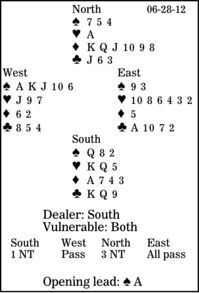Bridge column, June 28: Use your spots to disrupt signals

At the bridge table, declarer does not try to disrupt the defense's signals at his own peril. In this deal, for example, how should South plan the play in three no-trump after West leads the spade ace and East drops the three?
North was right to respond three no-trump, especially with the singleton heart ace. If he had held, say, a low heart and three spades to the ace, he might have suggested a diamond contract.
The contract is in jeopardy only if East has the club ace and two or three spades. Then, if West shifts to a club at trick two, East can push a spade through declarer's queen at trick three.
How will East signal at trick one?
He is being asked to show or deny the spade queen. And to make it look like East is encouraging, South must drop his spade eight at trick one. Then if West continues spades, the contract succeeds. But if South plays his two, West should shift to the club eight (high to deny an honor).
Yes, if East holds Q-3 or Q-3-2 of spades, there is a strong case for his playing the queen, but South must do the best he can. The principle is that declarer should signal like third hand (East). If South wants the suit led to be continued at trick two, he should play an unnecessarily high card. If he prefers West to shift, declarer should contribute his lowest card.
** ** **
COPYRIGHT: 2012, UNITED FEATURE SYNDICATE
DISTRIBUTED BY UNIVERSAL UCLICK FOR UFS

